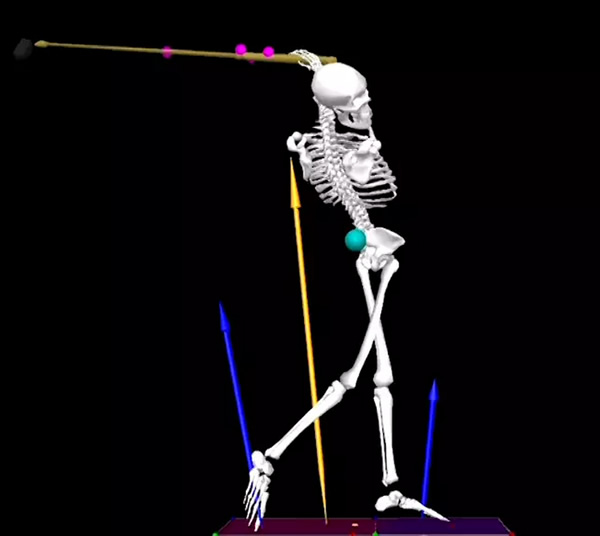Ground Reaction Forces
Before we dive into ground reaction forces, let's cover a few basic definitions.
Kinematics is the study or description of motion.
Kinetics is the study or description of the forces that create motion.
Why are kinetics important?
Historically, almost all of the focus has been on motions in the golf swing. Understanding how a golfer is creating these motions can be extremely useful in helping assess a golfer’s current swing and produce possible pathways for swing development. Forces created are not visible to the eye. Understanding what forces are being applied helps us know what motions to expect and where movement corrections need to occur.
What are the arrows?
 In our software, you’ll typically see three arrows. The two blue arrows are the right foot force and the left foot force. The larger yellow arrow is the Combined Ground Reaction Force, and is the sum of the right foot force and the left foot force.
In our software, you’ll typically see three arrows. The two blue arrows are the right foot force and the left foot force. The larger yellow arrow is the Combined Ground Reaction Force, and is the sum of the right foot force and the left foot force.
The force arrows are scaled so they show how big the vertical and horizontal forces are. As the vertical force increases, the arrow gets taller. As the horizontal force increases, the arrow will tilt more to the side. The scale for the height and side tilt is the same, so if the height of the arrow is equal to how much it is tilting (exactly a 45°), then the vertical force is exactly the same as the horizontal force. Typically the vertical forces are substantially larger than the horizontal forces during the golf swing.
The bottom of each arrow is located at the center of pressure for that arrow. So the right foot ground reaction force arrow will be at the average location of the vertical force applied by the right foot only. The left will be the average location of the left foot only, and the combined ground reaction force arrow will be at the center of pressure of all force.
In the software we use in the Golf Teaching and Research Center, the location of the center of mass is shown with a blue-green ball. Knowing where the center of mass is and how it is moving is very helpful in golf swing analysis. It can be considered the point in the body where the overall force is being applied, as well as the point about which we we can use the ground reaction forces to create rotation.
Why “Ground Reaction Forces”? Why not show the force we apply?
If you recall Newton’s 3rd law: for every action there is an equal and opposite reaction. As we push on the ground, the ground “pushes” back exactly the same amount.
The reason we show the “Ground Reaction Force” is because that force shows how the body is going to move, and specifically how it will accelerate. Think of it this way: if you did not have the ground under you, you would start falling. The ground holds you up, or pushes up on you to keep you from falling. So a ground reaction force that is tilting to the right will accelerate the body to the right.
This video shows how the body moves in response to ground reaction forces we create.
The purpose of this example is to show how the body moves in response to the ground reaction forces we create. To demonstrate this we use a simple example of a vertical jump. We will slow down the jump and we'll turn on the right and left foot forces and the combined ground reaction force in the middle. By slowing down the jump even more, you can see the big yellow combined force arrow really starts to drop and then we can see him start to move down.
Remember, that forces show intent or what direction you want to move. So the arrows move before we can see a change in motion. Once he has dropped down, what he wants to do is slow his descent and begin jumping up. So he starts applying more and more force. You can see that the vertical force is getting larger even though he is still moving down. To slow his descent, the force has to be greater than his body weight. So the arrows are now higher than they were when he was standing still.
Once he reaches the bottom of his jump he continues using the same large vertical force to drive himself up. And he maintains his large vertical force until just before his feet leave the ground. While in the air the ground reaction force will obviously be zero. Then he will land, stop his descent and finally, his vertical forces settle in as he returns to standing still. So ground forces tell us where we want our bodies to go. The bigger they are, the more they'll accelerate in that direction.